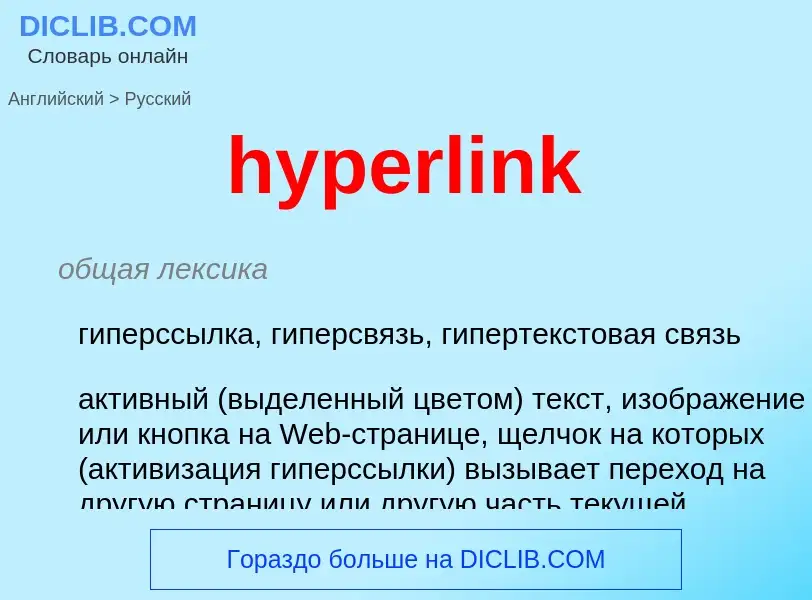Перевод и анализ слов искусственным интеллектом ChatGPT
На этой странице Вы можете получить подробный анализ слова или словосочетания, произведенный с помощью лучшей на сегодняшний день технологии искусственного интеллекта:
- как употребляется слово
- частота употребления
- используется оно чаще в устной или письменной речи
- варианты перевода слова
- примеры употребления (несколько фраз с переводом)
- этимология
hyperlink - перевод на русский
общая лексика
гиперссылка, гиперсвязь, гипертекстовая связь
активный (выделенный цветом) текст, изображение или кнопка на Web-странице, щелчок на которых (активизация гиперссылки) вызывает переход на другую страницу или другую часть текущей страницы. В общем случае - средства компоновки (в том числе задания взаимосвязей между отдельными элементами) электронного документа, содержащего текстовые, аудио- и видеоданные
Смотрите также
общая лексика
гипертекст
любой текст, содержащий гиперссылки (указатели) на другие документы. Способ представления информации с помощью связей между документами. Термин был введён Тэдом Нельсоном (Ted Nelson) в 1965 г.
технология, обеспечивающая поиск заданных тем в текстовых массивах. Поиск обеспечивается включением в тексты специальных указателей, называемых гипертекстовыми ссылками (hyperlink, links), - это слова или фразы в документе, которые, будучи выбраны читающим, вызывают переход в другой документ и вывод его на экран. Гиперссылки при отображении текста на экране обычно подчеркнуты сплошной чертой или выделены цветом. В современных системах гиперссылки могут быть не только на текст, но и на графические изображения, звуковые и видеофрагменты. Это расширяет понятие гипертекста до понятия гипермедиа (hypermedia)
существительное
вычислительная техника
гипертекст
Определение
Википедия

In computing, a hyperlink, or simply a link, is a digital reference to data that the user can follow or be guided to by clicking or tapping. A hyperlink points to a whole document or to a specific element within a document. Hypertext is text with hyperlinks. The text that is linked from is known as anchor text. A software system that is used for viewing and creating hypertext is a hypertext system, and to create a hyperlink is to hyperlink (or simply to link). A user following hyperlinks is said to navigate or browse the hypertext.
The document containing a hyperlink is known as its source document. For example, in an online reference work such as Wikipedia or Google, many words and terms in the text are hyperlinked to definitions of those terms. Hyperlinks are often used to implement reference mechanisms such as tables of contents, footnotes, bibliographies, indexes, letters, and glossaries.
In some hypertext, hyperlinks can be bidirectional: they can be followed in two directions, so both ends act as anchors and as targets. More complex arrangements exist, such as many-to-many links.
The effect of following a hyperlink may vary with the hypertext system and may sometimes depend on the link itself; for instance, on the World Wide Web most hyperlinks cause the target document to replace the document being displayed, but some are marked to cause the target document to open in a new window (or, perhaps, in a new tab). Another possibility is transclusion, for which the link target is a document fragment that replaces the link anchor within the source document. Not only persons browsing the document may follow hyperlinks. These hyperlinks may also be followed automatically by programs. A program that traverses the hypertext, following each hyperlink and gathering all the retrieved documents is known as a Web spider or crawler.


![SRI]], 1969 SRI]], 1969](https://commons.wikimedia.org/wiki/Special:FilePath/SRI ARC Engelbart Nov 1969.jpg?width=200)
![How internal [[MediaWiki]] links work when one wants to create a link that displays words different from the linked page's title. How internal [[MediaWiki]] links work when one wants to create a link that displays words different from the linked page's title.](https://commons.wikimedia.org/wiki/Special:FilePath/Wiki-linking.png?width=200)
